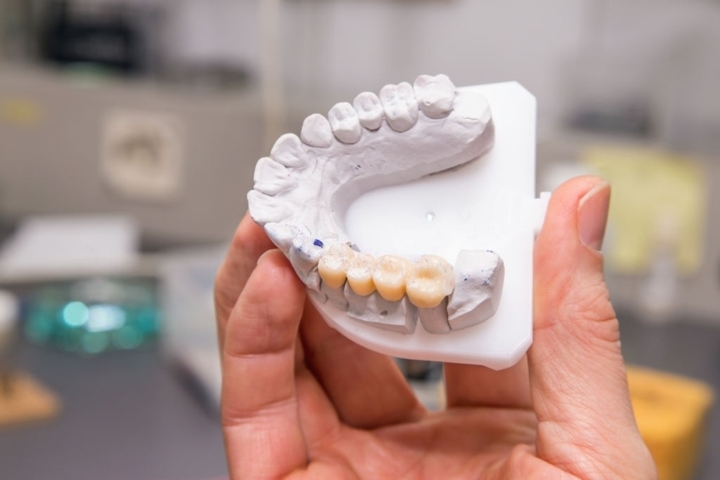
Dental bridges overcome the gaps!
Imagine smiling without teeth, especially the front ones; even the imagination is scary, right? That is why the replacement of missing teeth is essential to restore your smile and your confidence. Many dental treatments help overcome the gaps created by one or more missing teeth, such as dental bridges, dentures, and dental implants.
What are dental bridges?
Dental bridges are an artificial replacement for one or more than one missing tooth. Dental bridges fill the gap with artificial teeth such as porcelain, metal, or Zirconium teeth; tooth replacements are necessary after tooth loss. The gap can cause severe dental problems such as gum diseases and dissolution of the jawbone.
What are the types of dental bridges?
Modernization in technology has made advanced dental treatments possible. Diverse treatment options are available to the patients now, and they can choose from the best. Different types of dental bridges can be custom-made according to the priorities and oral health of the patient.
- Fixed Bridges:
These are traditional dental bridges, which cannot be removed by the patient. Support is taken from the healthy teeth next to the gap created by missing teeth. Usually made of ceramics and porcelain, these are the most commonly used dental bridges.
- Removable Bridges
As the name indicates, the patients can remove these types of dental bridges for cleaning purposes. Removable bridges are also widely known as dentures.
- Implant-retained bridges
These are the best and healthiest kind of bridges but are expensive. An implant supports the dental bridge; hence it does not become loose over time.
Why do I need a dental bridge?
The need for a dental bridge arises when the patient loses a tooth or teeth. When a tooth is lost, a gap is created between the teeth, and if the gap is left untreated, it raises several dental issues such as mobility in teeth, mal-alignment of teeth, gum diseases, resorbed jawbone. Tooth loss can occur due to several reasons;
- Tooth decay
- Gum diseases
- Trauma
- Extraction
If a patient presents with the need for dental bridges, the treatment should be done right away.
How to get a dental bridge?
The dentist will brief you about the whole dental procedure to get a dental bridge installed in your mouth. Dr. Shoaib Durrani at Durrani’s Dental Clinic always explains the process before moving on with the treatment.
The teeth that exist right next to the dental space at both ends (abutments) are reduced and shaped because they will house and support the dental caps (dental crowns) to support the bridge and the artificial teeth that will replace the missing teeth. The tooth’s preparation is done under local anesthesia to save the patient from any pain and discomfort. The bridges are custom-made at the laboratory and only cemented after the required area is fully prepared; hence it is a two-visit treatment usually. One for preparation and impressions, and the final one in which the bridge is permanently cemented or bonded onto the prepared teeth.
Which is better? A dental bridge or an implant?
These are the two basic ways to get a fixed tooth replacement. Both of the procedures have their respective advantages and disadvantages over each other.
The long-term success of all dental prostheses depends on several factors including the overall health of the patient, oral hygiene maintenance, and regular dental cleanings. Which treatment is a better option for which patient? that is the real question. For example, patients with uncontrolled diabetes or excessive smoking habits are very poor candidates for dental implants, a dental bridge is a good fixed tooth replacement option here. Similarly, in patients where the adjacent teeth are mobile and have less bone support, a dental bridge will be a poor treatment choice deemed for failure while dental implants will be the recommended treatment.
Based on various clinical evaluations and reviews, the long-term success of both these treatments is 10-14 years when placed in the right patient by the right dentist.
Is it painful to get a bridge?
Short answer: No.
With the latest and most advanced techniques coming into play, “painful dentistry” is ancient now. Local Anesthesia is administered on the first visit during the preparation of the adjacent teeth to ensure there is no pain during or after the preparation.
The second and final visit usually requires no anesthesia even, since the temporary bridge is removed and the permanent bridge is permanently cemented or bonded to the teeth.
What is a porcelain fused to metal (PFM) dental bridge?
When dealing with dental treatments, aesthetics and strength is of utmost importance. Porcelain dental bridges are fixed, aesthetically pleasing, strong, and long-lasting fixed bridges, widely used in dentistry.
What are the benefits of porcelain (PFM) dental bridge?
Porcelain dental bridges are famous for several factors:
- Aesthetically acceptable
- Durable
- Resistant
- Strong
- Restores your smile
- Restores the anatomy of your face
- Reduces the risk of secondary dental issue.
What are the disadvantages of porcelain (PFM) dental bridges?
With benefits come disadvantages too; nothing is perfect; although porcelain dental bridges are almost nearly perfect, they also have their cons. Such as;
- Difficulty in cleaning the area where the bridge is fixed.
- Secondary dental issues such as gum disease and infection can occur.
- Healthy teeth on either side of the gap have to be slightly reduced to place the bridge on them.
- If any part of the bridge is damaged, the whole bridge has to be removed.
- If the bridge is not fitted well, it can cause dental issues, pain, and discomfort to the patient.
- Although the aesthetics are better than pure metal bridges, they are still in second place when compared with pure ceramic bridges.
Many disadvantages can be avoided if the treatment is done correctly by the dentist and the patient maintains good oral hygiene. To get the best possible dental care, call us at +92-21-37227441 to book an appointment at Durrani’s Dental Clinic because we acknowledge your problems and treat them in the best way possible.
How long does a dental bridge last?
Dental appliances need great care and routine dental check-ups to ensure that they are in good condition. When maintained properly, dental bridges can last up to 10-14 years or even more. Dentistry is not painful or expensive if the dental visits are on time, and the patient follows all the instructions properly as given by their dentist.

